Chris Meyer
President, Ontario Association of Physics Teachers
Hybrid Teacher-Coach for Science, Toronto District School Board
christopher.meyer@tdsb.on.ca
Who really likes group work? You know, like when your admin groups the staff at meetings to work on exciting, meaningful tasks? Many students grumble and resent group work, some of them knowing that they will have to pull the full weight of their team. There is a good chance that you did totally fine at school without much meaningful group work, so why bother, right? The reality is that group work is often organized poorly or haphazardly, making for an unsatisfying experience. However, when done well, group work is the most effective learning environment for the vast majority of students. Education research has compared the learning outcomes of many different learning environments and the ones that consistently come out on top are those that deeply integrate group learning
1. If you haven’t been a fan of group work in the past, I encourage you to read on! We will explore how the brain works, how group work helps it, and share some tips that will hopefully encourage you to look at group work in a new light.
You Don’t Know What You Know Until …
A certain political figure from the past received much notoriety for his statement:
“Because as we know, there are known knowns; there are things we know we know. We also know there are known unknowns; that is to say we know there are some things we do not know. But there are also unknown unknowns — the ones we don't know we don't know”
Bonus points if you can name that person
2! Deciding whether you “know” something is quite tricky. How often in class have you confidently launched into an explanation, realized part way through you don’t know the answer, and muddled your way through a tortured, unconvincing conclusion? (Yup, that was me … more than once.) To help us understand why this happens, we turn to cognitive psychologists who explore how people learn and how we store and recall knowledge. The reality of the human brain is this: we don’t know if we know something until we carefully construct a complete explanation, like when we describe it out loud or write it in our own words. Over the years I have often said to students and teachers, “C’mon, you either know it or you don’t”, but the cognitive science has proved me wrong!
How We Structure and Access Knowledge
Our brains don’t store knowledge as complete, self-contained units, like digital information stored in a computer. Instead, our knowledge is stored as a web-like set of neural connections between simpler, related ideas. Each simpler idea is also a network of connections, and so on until we reach the smallest units of knowledge
3,4. These units of knowledge and the webs of connections form a person’s knowledge resources. I have created an illustration of this for the topic of fractions that shows higher-level ideas about large and small numbers.
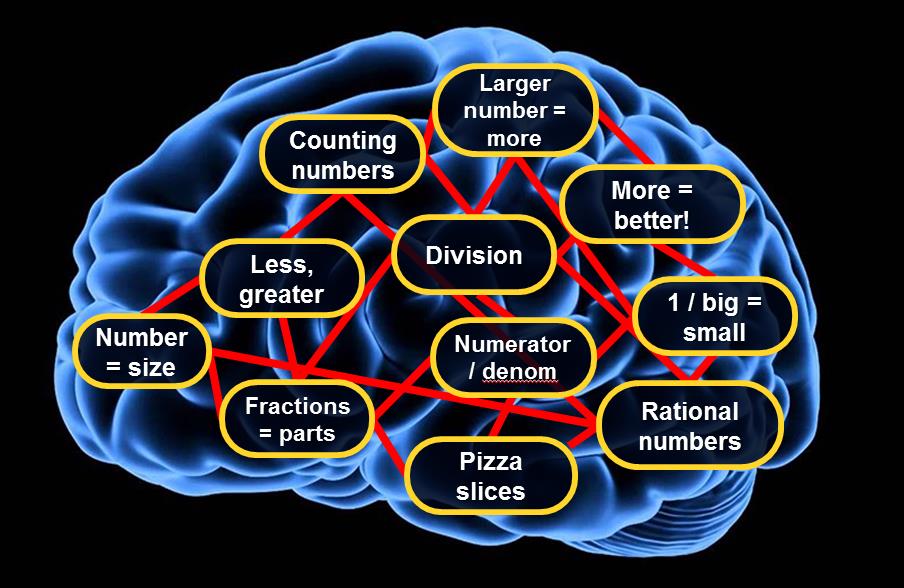

When we learn something new, neural connections between units of knowledge will strengthen, creating a web that corresponds to the new idea. Every person’s web of connections will be different, emphasizing different relationships between ideas and perhaps missing some entirely. Deep understanding results from a thick web of connections and weak understanding from a sparse web. The fun part is what happens when we try to access knowledge and recall an idea. Ideas are not recalled whole, like how a computer loads a complete file consistently every time. Instead, knowledge is reconstructed by activating different parts of the web of knowledge resources
5. This happens every time we access knowledge. Depending on the context of the situation, the emotional state of the person, and the strength of the connections at that moment, different parts of the web will activate and different results can come out! For example, we might ask a young student, “Which number is larger: ½ or ¼?” The result is a complex competition between the activation of different networks of knowledge.
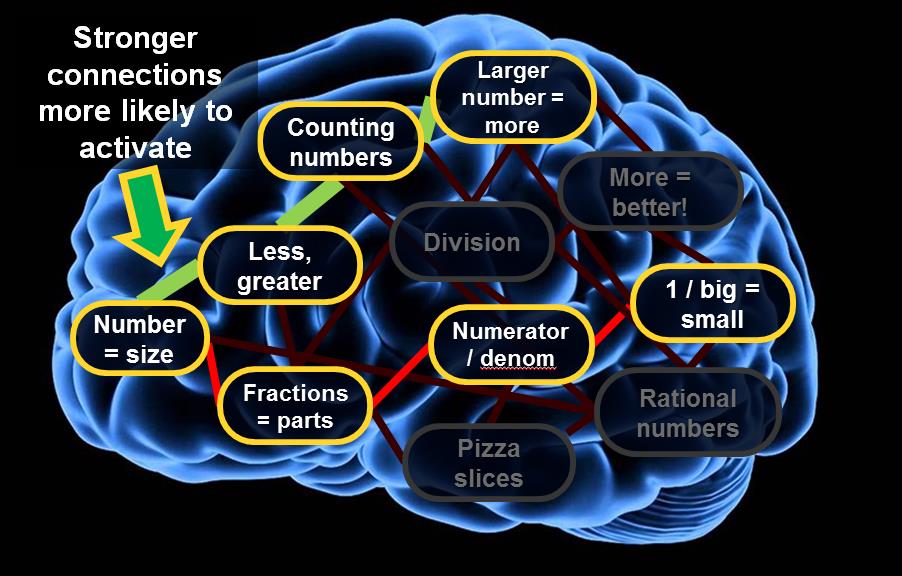

In the young student’s brain there is a path that leads to the correct answer of ½. But there is also a path that leads to the answer ¼, because the idea that the number 4 is greater than 2 is deeply ingrained. Depending on the day, either result could come from the young student. Teachers have both pathways as well, but the correct one has been so carefully reinforced over many years that it activates very reliably (we hope!). When the connections for an idea are very strong, the knowledge is very stable and activates consistently. When the connections are weak and tenuous, different parts of the network get activated every time and what results is pretty much unknown until the person opens their mouth! This explains why it is possible for a student (or a teacher) to honestly believe they know something until they go through the process of activating their knowledge resource networks and discovering what does or doesn’t come out!
The Skeptical Mind
There is a small group of people out there who really muddle our understanding of how learning works. They have practiced a helpful ability to such a high level of fluency that the rest of us don’t notice it being used. This ability can be subtle, so we shouldn’t feel too bad for missing it. What is it? The ability to talk through an idea to themselves in an internal monologue. All of us do this, but some people have the ability to critically debate in their own mind: to really hash things out, poke holes in their own arguments, find the exceptions, explore critical cases, uncover new details, and not let up until all the challenges have been exhausted. The most amazing thinkers I have met do this almost effortlessly, as I have noticed when they think out loud. For the rest of us, we think about things a bit, decide “good enough!”, and move on often with a lot left unexplored. This is one reason why writing a good old-fashioned lecture is great for the teacher —it usually forces us to follow each idea to its proper conclusion with no “good enough!” cop-outs. Unfortunately, the good old-fashioned lecture is not great for learning: writing it is the valuable experience; being lectured at it is not!
Group Work Triggers Active Learning
Now we get to the heart of the matter: why group learning is so valuable when done well. Most of us don’t (yet) have a highly-developed inner monologue that is great at skeptically examining new ideas. Working in a group on a well-structured task provides opportunities to say out loud what you are thinking, contrast that with others, and sort through the differences. My students agree:

 (I hope the “other people” weren’t injured!)
(I hope the “other people” weren’t injured!)
When students are talking and writing about science ideas in their own words, they are taking a big step forward in their learning. Lively group discussions prompt us to activate our knowledge resources, especially those tenuously connected to new ideas. Thoughtful discussion gives us immediate feedback on our thinking that can help us catch misunderstandings before they become reinforced and deeply ingrained.


Lecture-based teaching seldom affords these opportunities, except for that small group of people with finely-honed inner monologues who manage to actively process the lecture material. For this reason, direct instruction (telling students what they should know) is not an active mode of learning. A traditional lesson often leaves students to do critical work on their own: the sorting out of ideas, either in class or outside of class, with little structure or meaningful feedback other than checking a textbook answer. This is why education research shows such clear differences in learning outcomes between active and passive modes
6.
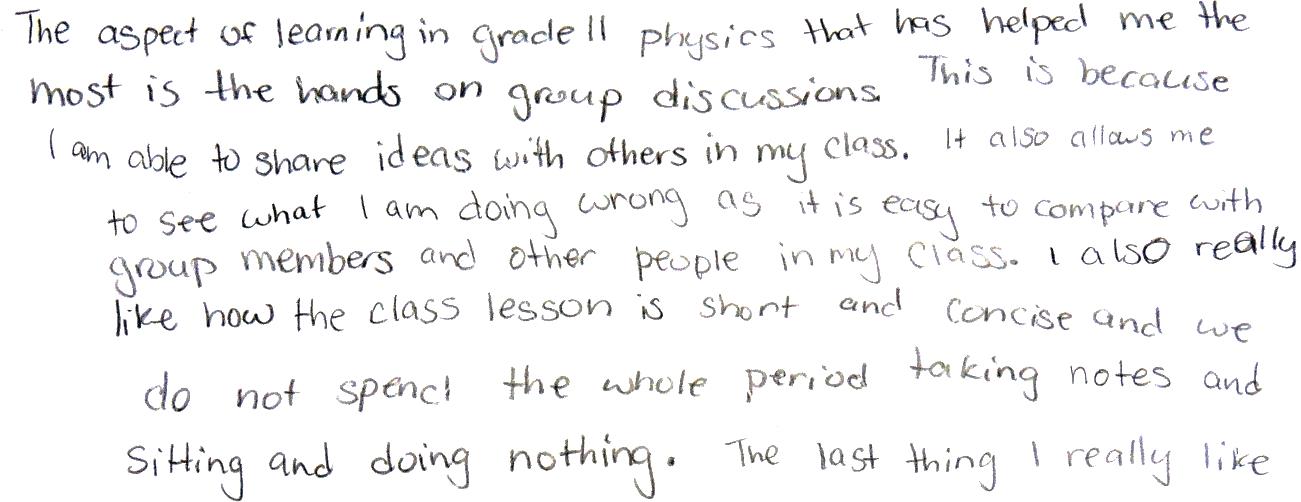

But I don’t like group work!
There are many good reasons to dislike bad group work; you and I probably suffer through it regularly at staff meetings. But as science teachers, we should appreciate that the science of learning is very clear: learning is a social process where people construct knowledge from smaller, simpler pieces; and active learning, especially involving groups, is the best way for most students to learn. However, there are real challenges in making the switch to using regular group work. Fortunately, the results are worth the effort. Let’s explore some of these challenges.
There is too much content to cover.
The Ontario science curriculum is fundamentally flawed, with an internal contradiction baked deep into it. The curriculum identifies three overall goals
7:
- To relate science to technology, society and the environment
- To develop the skills, strategies, and habits of mind required for scientific inquiry
- To understand the basic concepts of science
These goals stress the value of scientific habits of mind and require, according to the science curriculum document, a special approach to instruction
7:


And here is the contradiction: both the active learning the curriculum document recommends and the development of the habits of mind require much more time than the volume of content allows for. My guess is that no one successfully taught this curriculum before it was published; it is simply not possible to cover all the expectations for the basic concepts of science in a way that honours the other goals. When I speak to people outside of the secondary education system, they emphasize the thinking skills, remarking that bits of content can be quickly learned but thinking skills and habits of mind require years to develop. Group work in our classrooms is time consuming, so we must cut out content. This allows us time to cover the core concepts really, really well — in fact, much better than before. A robust core of learning allows people to quickly pick up missing bits of content later, when the content is actually necessary
8. The side benefit of all this is that the learning process is more enjoyable: students aren’t being rushed through content and notice that they understand the material and feel successful. One of my grade 9 students commented:
 Students don’t like group work
Students don’t like group work
Nobody likes bad or ineffective group work. For group work to be successful, we need to do a few things:
- Explain and regularly reinforce the rationale for and benefits of learning in groups.
- Train students how to work in structured groups where they follow roles
- Ensure individual accountability: each person is responsible for submitting work written in their own words.
- Be flexible and mindful of your choice of group members: their personalities, strengths, weaknesses, past experiences with one another, and motivation levels.
- Provide meaningful tasks where group work is helpful and needed. Fill-in the blanks don’t make for engaging group work.
When this is done, most students work well in groups and enjoy it. I used to survey my students at the end of grade 12 physics about their group work experiences. Here is their feedback:
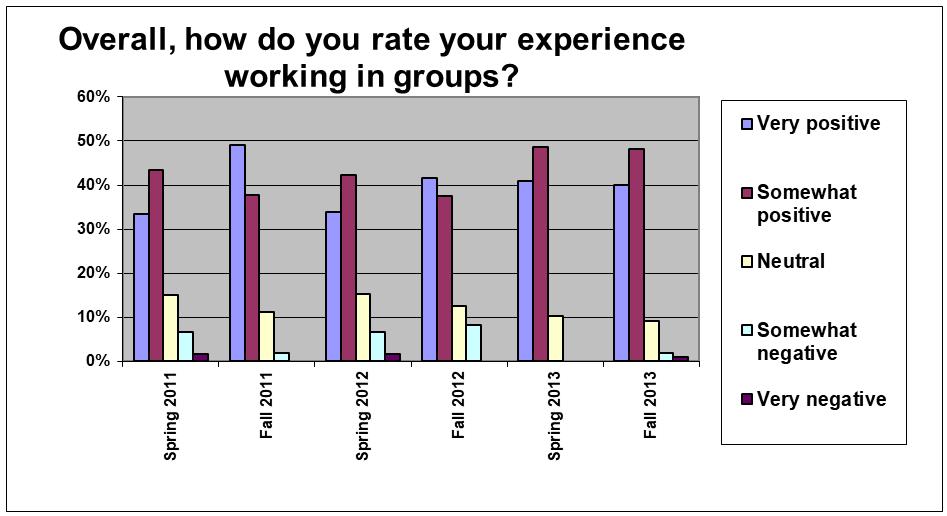

Group learning is not suitable for my students
Visitors to my class comment on the amount of on-task behaviour, how students quickly get started, and the rich group discussions they have. Then the visitor usually says, “but my students couldn’t do this.” These visitors are wrong. We work hard from the first day of class to develop the learning culture that visitors see months later. We spend a few lessons focussing just on the learning skills, habits, and routines that support effective group work. Here are two of my grade 9 students:




I have used my preferred format (group work every day with structured groups of 3 or 4) in grades 9, 11 and 12. Others have used this format with applied classes and elementary classes. What makes it successful is careful training for the students, meaningful tasks that match their ability or interest levels, and flexibility. Group work is not magical or perfect. There are days when my classes are less focused or productive, and on those days, I might shift the work to involve more whole-class discussions and individual writing.
Students won’t learn it properly
Many scientific ideas are complex or challenging. It took communities of thinkers thousands of years to nail this stuff down, so how can students possibly get it right on their own? There are three parts to my response to this challenge: (1) students get very frequent feedback so they do not flounder; (2) the learning process is highly structured so students can accomplish much on their own; and (3) the teacher’s energy is focused on students’ immediate learning needs. Let’s look at each of these.
Students can get feedback on their ideas in many ways:
- Talking with their group members
- Groups comparing work on whiteboards
- One group presenting an answer to the class
- Conversations between the teacher and group
- Whole-class discussions led by the teacher
- Mini lessons that discuss or clarify the immediate questions students are working on
Group work and inquiry do not mean that students are just making stuff up on their own; that is the recipe for educational frustration and disaster. Instead, the lessons should:
- be highly structured to guide student thinking in productive directions
- present or solicit multiple ideas for students to wrestle with and compare
- model the thought processes that originally led scientists through the development of the concepts
- provide opportunities for students to check their understanding using realistic applications
- generate a sense of success
When students are working effectively in groups, the teacher’s time doesn’t need to be spent just transmitting information. Instead, it can be focused on much higher-order tasks such as:
- monitoring group conversations
- interviewing groups to check for understanding
- providing impromptu mini-lessons on any key ideas that need illumination or reinforcement
- helping students and groups maintain focus and feel successful about their work


I don’t know how to run this type of class
Most of us did not learn in this way when we were students. Most of us were not formally trained to teach this way in teacher’s college. There is a real learning curve for us, so here are my tips:
- Be patient with yourself. It won’t be perfect the first time. It will be much better the second time. But you need to make mistakes and cut yourself some slack in order to learn.
- Listen to your students; they are your guide. The best part of teaching using group work is that you get to hear your students talking about the scientific ideas. This is both surprising and enlightening. You need to learn how they think about new scientific ideas. Only after that you can be prepared in advance to address the challenges they will have.
- Students set the pace. I find diligent students tend to work through science ideas at about one-third the speed I used to present the ideas in a lecture-style lesson. This can’t be rushed.
- Maintain high standards of behaviour and work. Discuss and regularly reinforce the best learning behaviours. Randomly collect work, give it a zero unless it is done to a high standard (i.e. no significant mistakes and thoughtfully written), and send it back to be improved!
Find good quality lessons to follow rather than making your own lessons. You have enough to do learning how to run a student-centred class. Writing a good group work lesson requires a whole other set of skills and is time consuming! (It takes me about 10 hours per lesson.)
How should I make the groups?
My recipe is this: form groups of three or four students randomly at first, and then more permanent groups that change each unit. In the first two weeks, I like having new, random groups every class. This provides me a good workout getting to know students’ names and allows me to observe them working together with different people. It also helps students to get to know one another. Once our introductory unit is complete, I establish permanent groups that last roughly one unit. I always ask for input from my students:
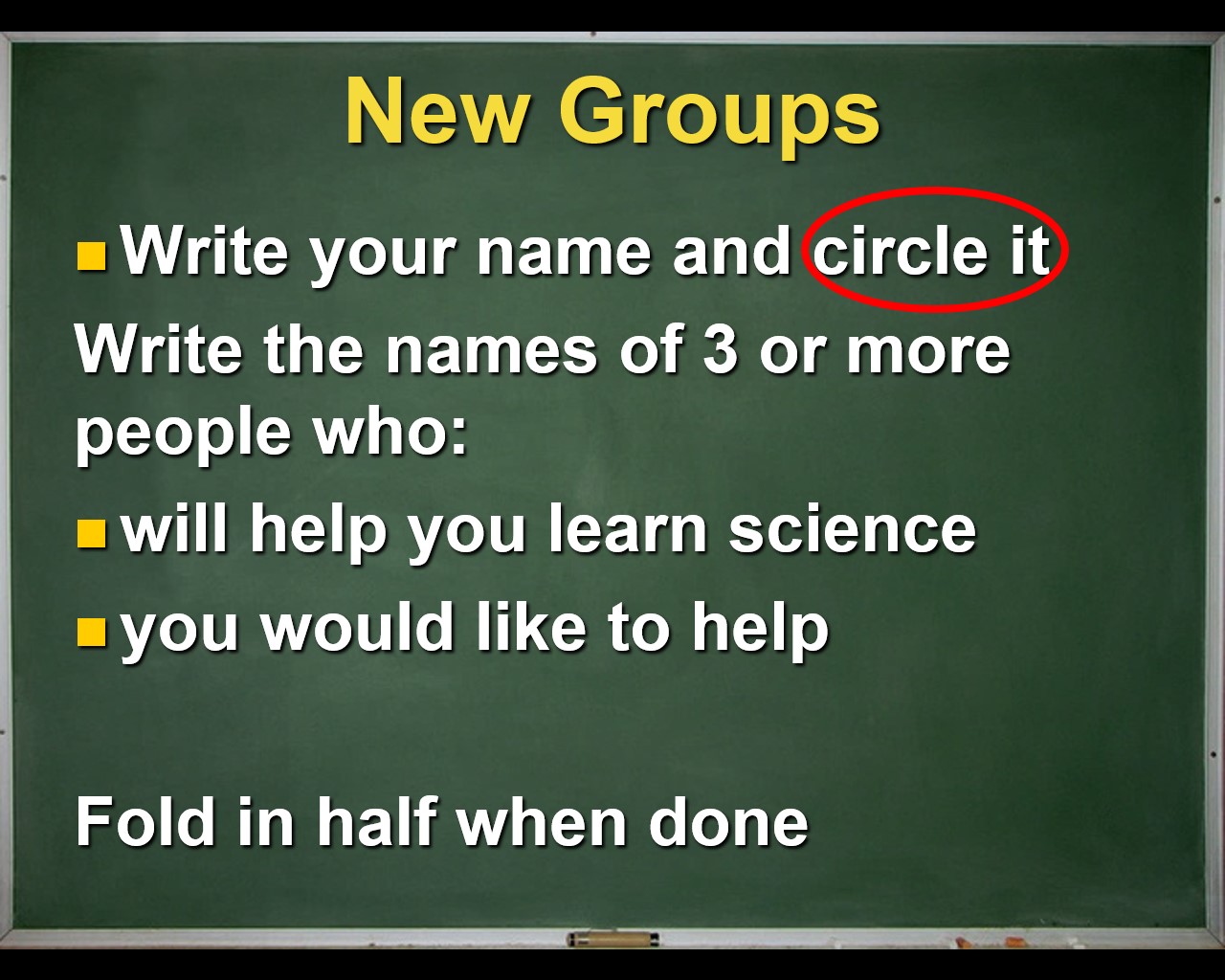

Student input is very valuable because there are so many factors that go into the successful combination of people into working groups: their personalities, their learning goals, their academic abilities, and their past experiences with one another. Then it turns into a puzzle as I shift around the pieces of paper with their input and form the groups. It is preferable to have a range of abilities, but sometimes a group of equal-ability students can work well when they have a good work ethic. I have tried putting the weak students together so I can focus attention on that group, but that did not work: other groups still need help and when I was gone the weak group would just flounder. A group of strong students can work well, when they have a thoughtful work ethic, but they might be likely to rush through work and not engage deeply with it. I am also careful not to form groups where the female students are a minority: there are challenging gender dynamics at work in a physics classroom and unless I know the female students well, I will make sure there is more than one female in a group. All of this might sound complicated and if it does, stick to random groups! I know a few teachers who do this throughout their course and have been very successful.
Bonus: the development of thinking, communication and teamwork skills
You want to impress an administrator? Changing to regular structured group work in your class allows students to practice many of the TDSB’s cherished global competencies
9. You can easily check many of those boxes! But most importantly, these are the skills that will help your students flourish in life outside your classroom. Practicing these skills every day makes a difference. Here is what my grade 12s say:
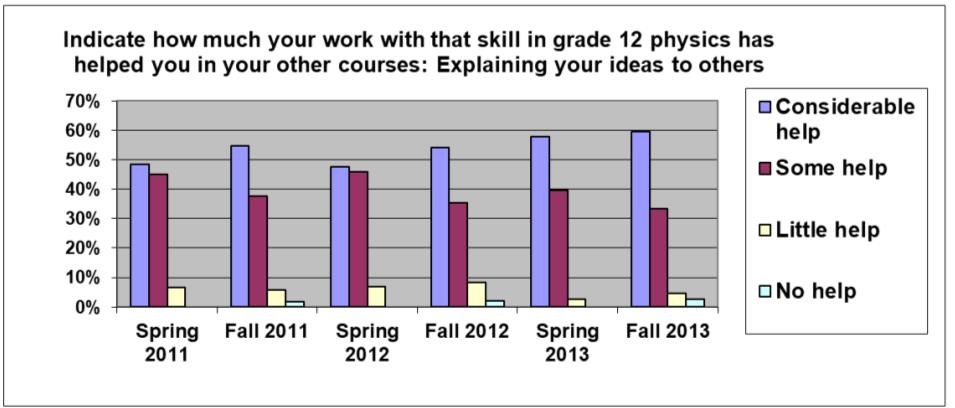
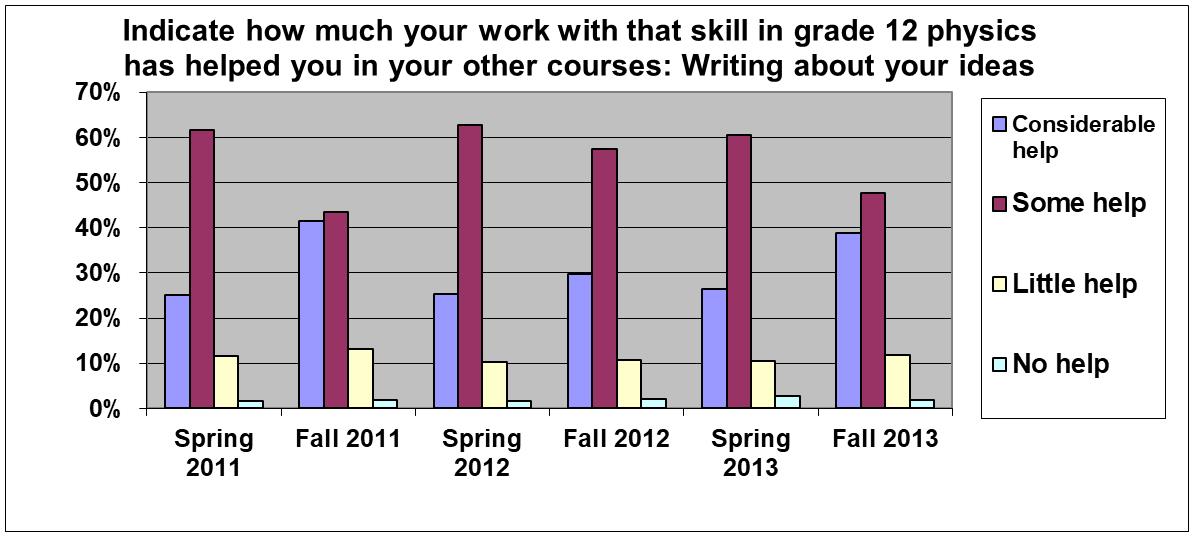

Final thoughts
After making the switch to daily group work, teachers find it hard to go back! The level of energy, thinking, and engagement in their classes is significantly higher — it's a very different learning (and teaching) experience. We are very fortunate that good-quality education research done by disciplinary experts is improving the world of learning. This is equally true of post-secondary education — it is has improved in the 20 years since I was there and regularly involves much more active learning and group work
10. If our goal is to prepare our students well for life outside of high school, we should learn what we can from the science of learning. Give regular, structured group work a try and feel free to explore the resources I have created
11 for examples of structured group-work lessons.
References
- Hake, Richard R. "Interactive-engagement versus traditional methods: A six-thousand-student survey of mechanics test data for introductory physics courses." American journal of Physics 66.1 (1998): 64-74. https://files.eric.ed.gov/fulltext/ED441679.pdf
- Rumsfeld, D. CNN, 2002. https://www.youtube.com/watch?v=REWeBzGuzCc
- Fuster, Joaquin M. “Cortex and mind: Unifying cognition.” Oxford University Press, 2003. https://psycnet.apa.org/record/2002-18891-000
- DiSessa, Andrea A. "Toward an epistemology of physics." Cognition and instruction 10.2-3 (1993): 105-225. https://psycnet.apa.org/record/1994-16202-001
- Redish, Edward F., and Eric Kuo. "Language of physics, language of math: Disciplinary culture and dynamic epistemology." Science & Education 24.5-6 (2015): 561-590. https://link.springer.com/article/10.1007/s11191-015-9749-7
- Freeman, Scott, et al. "Active learning increases student performance in science, engineering, and mathematics." Proceedings of the National Academy of Sciences 111.23 (2014): 8410-8415. https://www.pnas.org/content/111/23/8410
- The Ontario Curriculum: Secondary Science. Toronto: Ontario, Ministry of Education, 2008. http://www.edu.gov.on.ca/eng/curriculum/secondary/science.html
- Schwartz, Marc S., et al. "Depth versus breadth: How content coverage in high school science courses relates to later success in college science coursework." Science education 93.5 (2009): 798-826. http://www.physics.emory.edu/faculty/weeks/journal/schwartz-se08.pdf
- Toronto District School Board. Global Competencies: https://sites.google.com/tdsb.on.ca/globalcompetencies
- Heron, Paula and Laurie McNeil, Co-chairs, Joint Task Force on Undergraduate Physics Programs. “Phys 21: Preparing Physics Students for 21-st Century Careers”, 2016. https://www.compadre.org/JTUPP/report.cfm
- Meyer, Chris, 2020. https://sites.google.com/tdsb.on.ca/htc-meyer/home
Tags: Pedagogy















